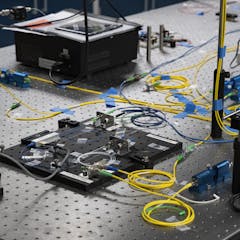
Todos os artigos de Physics
Exibindo 101 - 120 de 460 artigos

Synchrony is ubiquitous throughout the universe. But physicists’ equations predicted there could also be erratic exceptions marching to their own beat. Now they’ve been spotted in firefly swarms.

A new particle accelerator has just begun operation. It is the most powerful accelerator of its kind on Earth and will allow physicists to study some of the rarest matter in the universe.

From electricity to X-rays, the Doppler Effect and even quantum theory, Proust’s writing is littered with physics references.

Radiation really is everywhere – and it’s not at all as spooky or dangerous as we often think.

Quantum entanglement is the stuff of sci-fi, advanced physics research and, increasingly, technology used by governments, banks and the military.

Quantum mechanics raised tough philosophical questions about the nature of the world – and a physicist named John Bell figured out how experiments could answer them.

A multitude of experiments have shown the mysterious phenomena of quantum mechanics to be how the universe functions. The scientists behind these experiments won the 2022 Nobel Prize in physics.

To think about new ways of transmitting science and to really innovate how we teach, the first step is creating an appropriate dialogue format. From there, everything becomes possible.

Strangely behaving matter could one day explain some of the mysteries of space.

Twisted laser light may help launch a revolution in technology.

From capillary forces to sand grain shape, the simple mix of sand and water hides the complexity within.

The Matter of Everything is a partial account of the history of physics, which leaves out a lot, including the story of some key women scientists.

Life on Earth has dramatically changed the chemistry of the planet. Astronomers will measure light that bounces off distant planets to look for similar clues that they host life.

A physicist explains how atoms arrange themselves into molecules – and how scientists are able to image these tiny bits of matter that make up everything around you.

Theories exploring the possibility of time travel rely on the existence of types of matter and energy that we do not understand yet.

Astronomers studying fast radio bursts recently discovered one that repeats, has a persistent radio signal and originated in a galaxy much closer than it should have.

Nuclear isomers are rare versions of elements with properties that mystified physicists when first discovered. Isomers are now used in medicine and astronomy, and researchers are set to discover thousands more of them.

Monte Carlo simulations can predict different potential outcomes because they provide for the presence of random variables or elements.

Sagittarius A* is a massive black hole at the center of the Milky Way. Now that astronomers have imaged it, they can begin to learn more about black holes within other galaxies across the universe.

Girls report not feeling clever enough to take physics.
